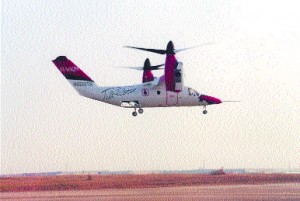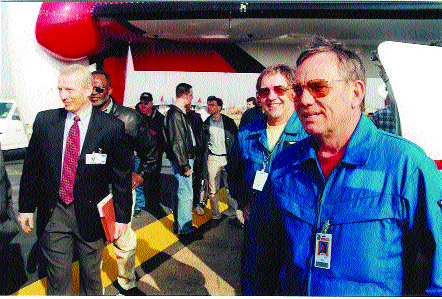By Daryl Muphy

Roy Hopkins (right), Bell/Agusta senior flight test pilot, and test pilot Dwayne Williams after the historic first flight of the BA609 tiltrotor. Hopkins is the world’s highest time tiltrotor pilot, with more than 1,000 hours in the XV-15, V-22 and BA609.
The long-awaited maiden flight of the Bell/Agusta BA609 tiltrotor in Arlington, Texas, on March 7, was proclaimed a historic occasion by Bell Helicopter Chairman and CEO John Murphey.
“This achievement is as remarkable as when the Bell X-1 broke the sound barrier more than 50 years ago,” he said.
The 37-minute first flight at Bell’s Flight Research Center on Arlington Municipal Airport was followed by a one-hour mission four days later. During the first test, which was unannounced, left and right pedal turns, forward and aft flight maneuvers, takeoffs and landings, nacelle position changes and stability were accomplished. The March 11 (termed “first formal”) flight was expanded to include forward flight in hovering mode at speeds up to 80 knots, and was witnessed by invited guests, including several who have placed orders for the aircraft.
“The flight was flawless,” said Roy Hopkins, Bell/Agusta senior flight test pilot. “The 609 performed exactly like we knew it would.”

John Murphey, Bell Helicopter Textron chairman and CEO, says the company has 70 orders for the BA609 from 40 customers. A 40-year veteran of Bell, he has been involved in the tiltrotor program for more than two decades.
Hopkins also flew in the test program for the V-22 Osprey. Dwayne Williams, Bell test pilot, flew as copilot on the 609 mission.
“Today’s flight of the BA609 marks the first flight of an aircraft available to the public that can not only fly with the speed and range of an airplane, but can take off, hover and land with the versatility of a helicopter,” said Murphey. “Until now, commercial helicopters were limited to a top speed of about 150 knots. The BA609 smashes through that barrier with a top speed approaching 300 knots.”
The BA609 is a six- to nine-place pressurized aircraft powered by two Pratt & Whitney Canada PT6C-7A turbines of 1,940 shp each. With rotors in vertical position, it can take off, land and hover like a traditional helicopter. With nacelles and engines tilted forward to the horizontal position, it can fly similar to a fixed-wing turboprop. The transition from one mode to the other will take 20 seconds. The aircraft has a cruise speed of 275 knots with maximum un-refueled range of 750 nm, or 1,000 nm with auxiliary fuel tanks.
Announced in 1996 as the civil follow-on to the military V-22 Osprey, the BA609 is a joint development with Italy’s AgustaWestland, which will also manufacture the aircraft in Europe. Fuji Heavy Industry of Japan will build the production fuselages for the BA609, and parts and components will be shipped to Bell’s final assembly plant in Amarillo, Texas, and Agusta’s in Italy.
Some critics have questioned the amount of time Bell has taken to get the 609 prototype in the air, but Murphey says customer interest is still high, and that the program is being deliberately paced as experiences with the V-22 Osprey are gained. Because of two fatal accidents in the military tiltrotor, service testing throughout the Osprey’s entire performance envelope is underway and will last until mid-2005.

Four prototypes will be flown for a total of 3,000 hours before the Bell/Agusta 609’s anticipated certification early in 2007.
Four BA609 test aircraft will eventually join the civil test program, and the plan calls for a total of 3,000 flight test hours before certification is received and deliveries begin in early 2007.
Murphey said the company currently has 70 orders for the approximately $10 million aircraft from 40 customers in 18 countries. That amounts to a three-year manufacturing backlog, so Bell has stopped taking orders until production schedules can be firmed.
Headquarters for the Bell/Agusta Aerospace Co. is at Alliance Airport near Fort Worth, where customer BA609 training will also be conducted and the delivery center located.
For more information, visit [http://www.bellagusta.com].

The Bell/Agusta 609 (shown here on its first public flight) can take off, land and hover like a helicopter and cruise like a fixed-wing aircraft.











